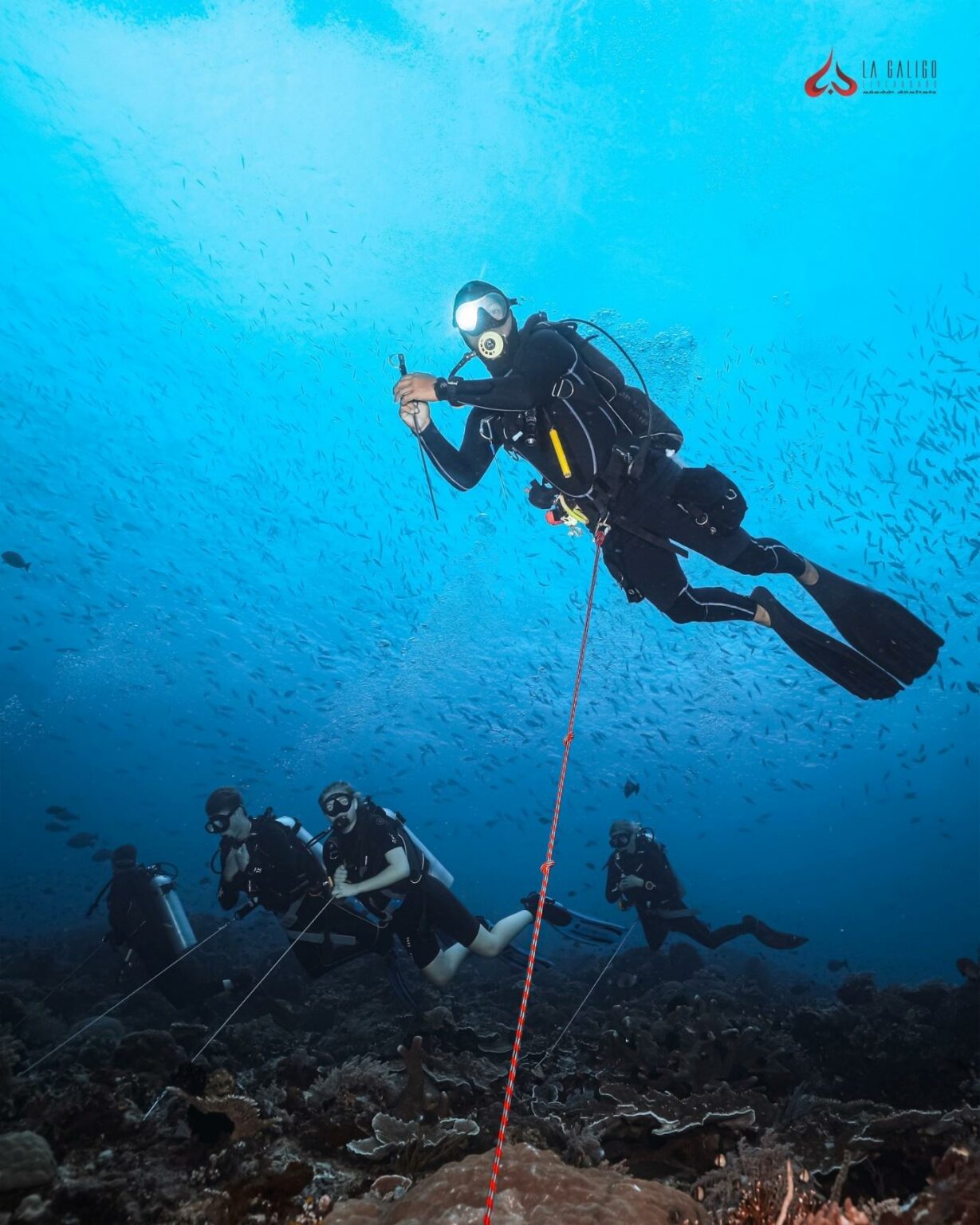Komodo is a great diving area, no doubt. Yet, the strong currents in various dive sites in Komodo can be quite scary for new-level divers. The burning question that arises is: Can beginners dive in Komodo safely?
The thing is, despite the challenges that Komodo presents, it remains safe to beginners. With proper guidance, preparation, and appropriate dive sites, even those new to diving can dive there safely. In this article, we will discuss how beginners can dive in Komodo.
The Short & Long Answer
Short answer is yes, it can be safe for beginners to dive in Komodo National Park.
Long answer is, it depends on which dive sites you are going to, with additional of some other aspects that you need to take into consideration.
Let’s take a look into the long answer and break it all down bit by bit.
Why The Currents in Komodo are Strong
The primary influence on Komodo currents is a force known as the Indonesian Throughflow.
It’s water moving from the Pacific Ocean south across the equator and down to the Indian Ocean passes through 4 points in Indonesia.
In fact, the level of the water in the Pacific Ocean to the north is 20 cm above average sea level and the water in the Indian Ocean to the south is 10 cm below average sea level, so the water literally runs downhill!
You can see this in the map below.
One of the four places that the water passes, is through the area of the Komodo islands, between the larger islands of Sumbawa to the west and Flores to the east.
The area between Sumbawa and Flores where the Komodo islands lie is an underwater shelf, so the seas are relatively shallow.
This rise in the seafloor pulls the rushing water travelling from north to south up and over the shelf.
This creates strong currents and draws in a lot of nutrient rich water through the area.
While most of the water flows through the deeper Sape Strait (around 300m depth), to the west of Komodo island, a lot of the water still passes through to the east of Komodo island too where most of the dive sites are located.
ALSO READ : Things To Do in Komodo Island
Where The Currents Are Coming From
So, this is a bit of an oversimplification of the process as there is actually rising and falling tides which cause movements in both directions at different times.
However generally the strongest force is from the Pacific side to the Indian side.
Also, if you look closely into it the Komodo area the throughflow, the wave is broken down into 3 smaller water passages:
- East of Komodo is the Lintah Strait
- The Sape Strait on the west of Komodo
- Between Flores Rinca is the Molo Strait.

The Strong Currents is Causing a Boom in Marine animals
This strong flow from the Pacific and Indian Ocean is great news for diving as rich nutrients in the water means that there is a boom in marine plants and phytoplankton.
These lead to a boom in small marine animals and zoo plankton who eat them.
This boom then in turn impacted in an increase in larger filter feeders like Manta Rays and Whales who eat them, and all other increasing fish and marine animal sizes as the energy from the food passes up the food chain.
The currents driven by the Indonesian Throughflow are the reason why the marine life in Komodo is so amazing.
The Downside of this Boom
But there is also a downside to these currents.
Strong underwater forces like this can cause dangerous down currents and eddies.
Divers can get into real trouble if they are unable to swim up to the surface or reversely if they get caught in an up current that forces them to surface quicker than is safe for decompression rates.
Currents underwater can also cause divers to become separated from their groups.
Even at the surface there are dangers with being swept away into the open ocean if you surface at the wrong spot or are separated from your group.
The strongest currents coincide with the best times to dive in Komodo for both weather and marine life.
This best season for diving in Komodo occurs from June to August during the area’s southeast monsoon.
Another factor that affects the strength of the currents is moon phase. The gravitational pull of a full moon or new moon will produce the biggest tidal changes and therefore suck and pull the most water with it through strong currents.
And a super moon, well that can bring super currents!

So Is it Safe for Beginners to Dive in Komodo?
At this point you might be thinking,
“Hold on, I thought I was reading a blog about safety for beginners in Komodo and the number of dives I need, not a lesson in oceanography and astrology?”
But it is all relevant.
It Can be Safe
You see, there are many dive shops that teach diving from open water level in Labuan Bajo and thousands of people have been certified in Komodo.
But for beginners, it is all about going to the right places at the right times, and then yes, it can be safe.
But on the opposite end of the spectrum if you go to the wrong place at the wrong time as a beginner, it can be a disaster.
This is why you need to dive with a reputable operator that has many years of experience to make sure you end up in the right place.
Avoiding the Currents by Checking The Moon Phase
There are things that you can do yourself before going to Komodo also to make sure that you have a safe and enjoyable time.
For instance, if you are a new diver and you know you don’t want to go at the times of strong current, plan around them as best as you can.
Komodo has some currents that can come out of nowhere and be in places where they shouldn’t be, but there are a few things that you can do to avoid them as a new diver.
It’s simple to check the moon phases for any time in the future, so plan a trip that is not on or close to a full moon, new moon, or super moon.
Also, plan a trip outside of the peak current months of June to August.
Dive in Safer Dive Sites
Even if you can not avoid these times then find an operator that has all divers of your experience level going on a trip and tell the dive shop, so that they take you to the sites that are prone to less current.
There are some dive sites that are heavy on current which may be too full on for new divers like The Cauldron (Shotgun), Batu Bolong, Castle Rock, and Three Sisters.
But then there are also some sites that are known for having little to no current like Sebayur Kecil, Tatawa Besar, Karang Makasaar (Manta Point) and Siaba Besar which are perfect for beginners or new divers.
Double Down on Your Safety Equipment
Certain safety equipment can help put your mind at ease when diving Komodo too.
A surface marker buoy (SMB) along with a whistle and signal light is essential for pick up at the surface.
This is especially if large waves have developed while under the surface making it hard for the tender operators to see you.
Your dive guide will always have a SMB with them but sometimes it also pays to take a personal one too just in case the worst happens, and you are separated from the rest of the group.
Another safety device that you could take to help in this situation too is a personal submersible GPS signaller.
These do not work underwater but are encased in a waterproof housing so that you can keep it strapped to your BCD or in a BCD pocket during your dive.
If you are lost on the surface, you activate it, and you will be rescued from your GPS signal.
They retail for about $220 USD for a model like the Nautilus Lifeline.
Underwater, a reef hook and line are always good to take on a dive.
If the current is getting a bit too intense, then you can always hook onto a bit of stable, nonliving reef to give yourself a bit of a breather and conserve energy.

Your Minimum Required Dive Logs to Dive in Komodo
On a Liveaboard
So now how about the number of dives you should have before diving in Komodo National Park?
Well, this all depends on the type of diving that you will be doing. If you plan to head out on a dive liveaboard in Komodo, then you should be at least Open Water certified and have a minimum of 40 in your dive logs before deciding to tackle Komodo.
The reason behind this is that all the liveaboard schedules will be going to both beginner and advanced sites as there is a mixed group of divers onboard that want to see the best sites in Komodo.
Forty dives are a rough guide to prove that you are comfortable enough in the water to take on the currents of Komodo, but everybody is different.
If you are a bit unsure there is always the option to hire a private, one on one guide on a liveaboard to make sure you are watched with full attention.
Also, going and taking the Advanced course with a drift diving specialty and peak performance buoyancy is a good way to test your skills and boost your confidence before a Komodo trip too.
Of course, if you have a group of divers with a lower experience level then you can always charter an entire liveaboard for your group with a custom itinerary to only visit the less advanced sites too.
On a Dive Center (Land-based)
If you are not diving on a liveaboard then you have more options to dive Komodo with a lower number of logged dives, or even to become open water certified at one of the dive shops based in Labuan Bajo.
The smaller number of divers that head out on a speed boat from Labuan Bajo to Komodo means that the operators can choose the sites more tailored to the group, especially if you are only doing one or two dives in the day.
Just make sure that they are a trustworthy operator with good guides, and they are not mixing you in with an advanced group heading out to Castle Rock!
So really when diving with a land-based operator there is no minimum dives you need to dive Komodo, it’s just about finding the right store at the right time, or alternatively hiring a private boat and guide if your group size is too small to private charter an entire liveaboard.
In Conclusion
This completes our guide to safety and the number of dives for beginners in Komodo.
In conclusion, yes, it’s possible for beginners to dive in Komodo given they choose the appropriate dive operator style, locations, and conditions.

